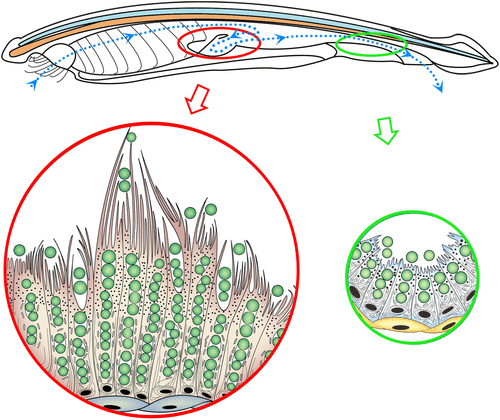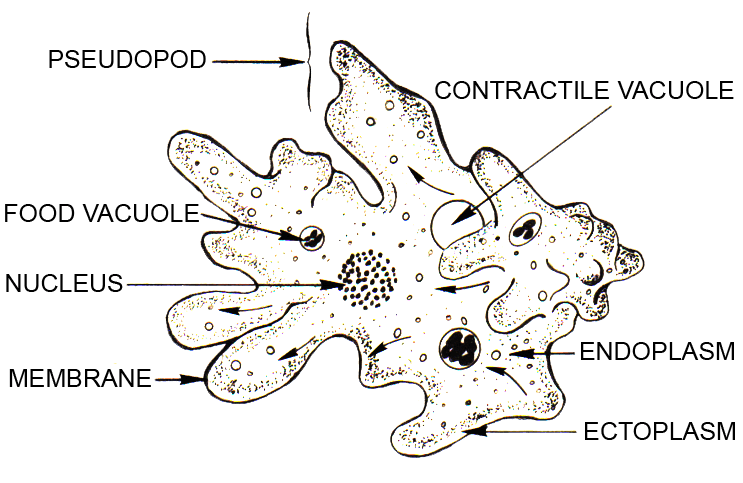
Intracellular digestion
n., plural: intracellular digestions
[ˌɪntrəˈ′sel·yə·lər dɨˈdʒɛstʃən]
Definition: digestion that occurs inside a cell
Table of Contents
Intracellular Digestion Definition
What is intracellular digestion? ‘Intra’ means “inside” and ‘cellular’ pertains to “cell”. Hence, intracellular digestion means digestion that occurs inside a cell. Let us further define the term, intracellular digestion. Intracellular digestion occurs in animals having only one opening in the gastrovascular cavity. In such animals, a single opening serves as both ‘mouth’ and ‘anus’. The food is ingested through the gastrovascular opening. Cells lining the gastrovascular cavity engulf it, and digestion takes place inside these cells, in their cytoplasm. The food is ingested through a process of phagocytosis. It is absorbed by the cells lining the gastrovascular cavity, wherein the process of digestion of food occurs. Intracellular digestion examples include sea anemones, coral, jellyfish, flatworms, and comb jellies.
Intracellular digestion is the breakdown of complex food to simple form inside the cellular cytoplasm. The materials or food particles are taken into the cell to be digested. Lysosomes and food vacuoles are responsible for this process. Intracellular digestion is characteristic of animals devoid of the digestive tract, such as unicellular protozoans, Platyhelminthes (flatworms), mollusks, Porifera, Ctenophora, Cnidaria (like sea anemones, coral, and jellyfish), and Pycnogonida. Evolution in the digestive system has led to evolutionary development in the animal kingdom. Based upon the mechanism of digestion, invertebrates can be classified as organisms with intracellular digestion and organisms with extracellular digestion. Etymology: “intra”, meaning “inside, “cellular”, from “cell”. Synonym: cellular digestion. Compare: extracellular digestion
Intracellular digestion vs. extracellular digestion
Extracellular digestion is seen in other animals that have a gastrovascular cavity with two openings and the mouth and anus are separate. Different segments of the gastrovascular cavity serve different digestive functions in such organisms as food travels from mouth to anus. Food ingested via mouth is transferred via the esophagus. Some animals have a storage organ such as birds with crops, from where food is moved from the esophagus into this storage organ. In birds, the food from the crop is mixed, churned, and digested in the gizzard (the “true” stomach of birds). Post digestion in the gizzard, nutrients are absorbed in the intestine, and waste is eliminated (castings) from the anus. Hence, in such animals, the breakdown of food occurs outside the cell’s cytoplasm, and therefore they exhibit extracellular digestion. Other examples of animals that do extracellular digestion are arthropods (e.g., grasshoppers), arachnids (e.g., spiders), and segmented worms (e.g., earthworms).
The special case of Amphioxus
Organisms that possess both intracellular as well as extracellular digestion, for example, Lancelets. See Figures 1 and 2, to learn about its digestive system.


Let us now understand how intracellular digestion differs from extracellular digestion through this table.
Table 1: Difference between Intracellular Digestion and Extracellular Digestion | |
|---|---|
| Intracellular digestion | Extracellular digestion |
| Breakdown of food occurs inside the cytoplasm of the cell | Breakdown of food does not occur inside the cytoplasm of the cell |
| It occurs in animals having only one gastrovascular opening that serves as both mouth and anus | Seen in animals that possess two openings in their gastrovascular cavity, i.e. separate mouth and anus |
| Ingestion of food is via phagocytosis | Ingestion of food via mouth |
| Here, only chemical breakdown of food occurs | Mechanical as well as the chemical breakdown of food |
| Undigested food is eliminated from the body through exocytosis | Undigested food is eliminated from the body via the anus |
| Breakdown of food occurs with the help of lysozymes | Digestive enzymes are involved in the process of digestion of food |
| They are seen mainly in protozoans, Platyhelminthes, mollusks, poriferans, ctenophores, cnidarians, and sea spiders. | Seen in organisms that possess alimentary canal for, e.g., humans, earthworms, spiders, etc. |
Function
Digestion of food is an essential requirement for any living cell. Food provides the necessary energy for survival.
In lower animals, intracellular digestion is the mode of food digestion. Cellular digestion can be further classified as
- Autophagic digestion: as the name suggests, “auto” means “self” and “phagy” means “eat”. So, autophagy means “self-eating“. In this type of intracellular digestion, breakdown of the internal component/content of the cell occurs or, in simpler words, self-eating.
- Heterophagic digestion: as the name suggests, “hetero” means “other” or “different” and “phagy” means “eat”. So, heterophagy means “eating others”. Herein, the food is phagocytosed and gets enclosed in a vacuole. The vacuole containing food is then presented for intracellular digestion.
It should be noted that in both cases — both autophagic and heterophagic forms of digestion, the lysosomal hydrolytic enzymes are involved in the digestion of the food within the cell.
Intracellular Digestion Occurrence
Where does intracellular digestion occur? Which organelle is responsible for intracellular digestion?
The organelle for the intracellular digestion of food particles is the lysosome. Lysosomes are membrane-bound intracellular organelle that is rich in digestive or hydrolytic enzymes. Therefore, lysosomes are the intracellular digestion organelle. The lysosomes have an acidic environment. This acidic environment is critical for the hydrolytic activity of the digestive enzymes present in the lysosomes. The acidic environment helps maintain the lysosome’s integrity and prevents hydrolytic enzymes from self-digestion of the organelle. Any rupture in the lysosomal membrane can result in loss of the organelle integrity, resulting in the release of hydrolytic enzymes in the cell’s cytoplasm. When multiple lysosomes release their content in the cell’s cytoplasm, it may result in cellular death. Thus, lysosomes form the cellular digestion centers.
Intracellular Digestion Examples
Examples of Intracellular digestion are found in Amoeba and Paramecium.
Amoeba digestion
Amoeba is a unicellular microorganism wherein the heterophagic mode of intracellular digestion occurs. Ameoba does not have a specific shape and keeps on changing its shape constantly. Amoeba has multiple finger-like projections, known as false feet or pseudopodia. When food is present near the Amoeba, the pseudopodium of Amoeba extends around the food, forming a vacuole. The hydrolytic enzymes in the vacuole break down the food into a simpler form. The nutrients from the digested food are then absorbed and distributed throughout the body.

Paramecium digestion
Paramecium is the unicellular, slipper-shaped microorganisms from protozoa. Characteristically, the paramecium possesses multiple hair-like projections on their body known as cilia. With the help of cilia, the paramecium engulfs the food particle or liquid into the food vacuole and presents it for intracellular digestion.
But where does digestion occur in a paramecium? In paramecium, hydrolytic enzymes are present in the food vacuoles. The food is broken down with the help of hydrolytic enzymes of the cytoplasm. The undigested food is then eliminated from the body through the anal pore.
Watch this vid to see the intracellular digestion in paramecium
This brings us to an important question- Do humans do intracellular digestion? The answer to this question is- Yes, humans have intracellular digestion. Now, this brings us to another question, Where does intracellular digestion occur in humans? The food consumed by humans is converted to chyme and mixed with various enzymes at a different location in the gastrointestinal tract. The emulsification of the food chyme by the bile salts in the gastrointestinal lumen is an example of extracellular digestion. However, lipids are taken up by the villi and transported to the intestinal cells, wherein lipids undergo oxidation is an example of intracellular digestion. This is because the lipids undergo the process of oxidation in the cell cytoplasm. Similarly, the breakdown of sucrose to glucose and fructose in the cell cytoplasm is an example of intracellular digestion.
READ:
- Digestion and Absorption of Food in Humans – Tutorial
- Digestive Enzymes – Extracellular Digestion in Humans
Try to answer the quiz below to check what you have learned so far about intracellular digestion.
References
- Hartenstein, V., & Martinez, P. (2019). Structure, development and evolution of the digestive system. Cell and tissue research, 377(3), 289–292. https://doi.org/10.1007/s00441-019-03102-x
- Berthet J. (1965). La digestion intracellulaire et les lysosomes [Intracellular digestion and lysosomes]. Archives de biologie, 76(2), 367–385.
- Glick, D., Barth, S., & Macleod, K. F. (2010). Autophagy: cellular and molecular mechanisms. The Journal of pathology, 221(1), 3–12. https://doi.org/10.1002/path.2697
©BiologyOnline.com. Content provided and moderated by Biology Online Editors.


